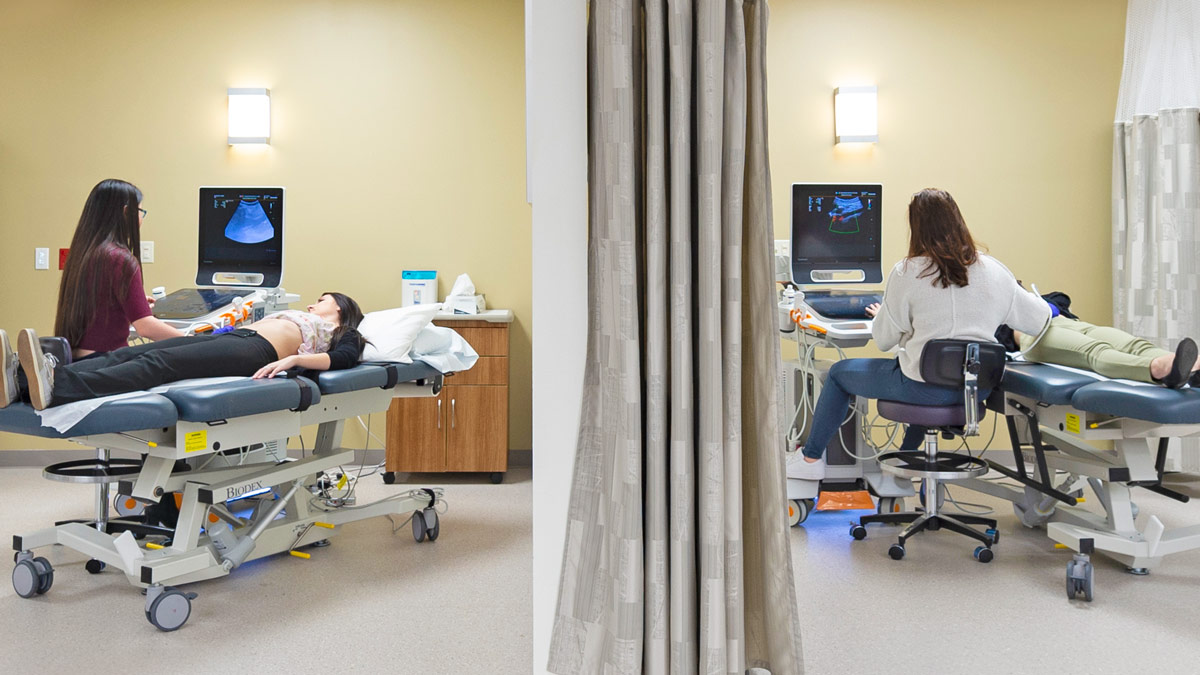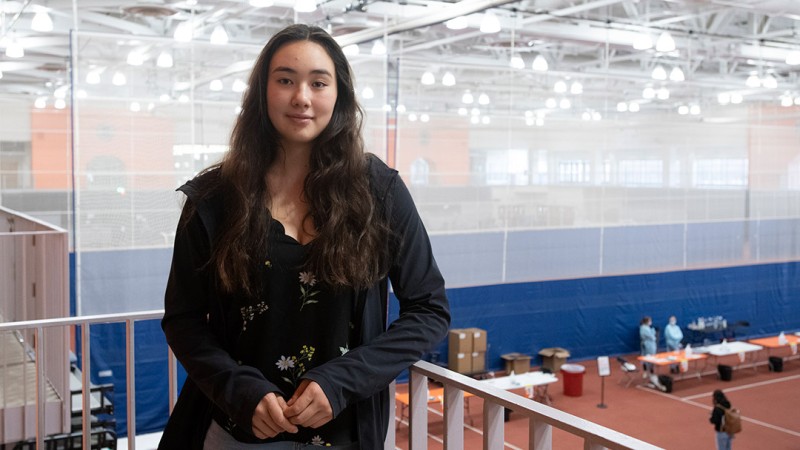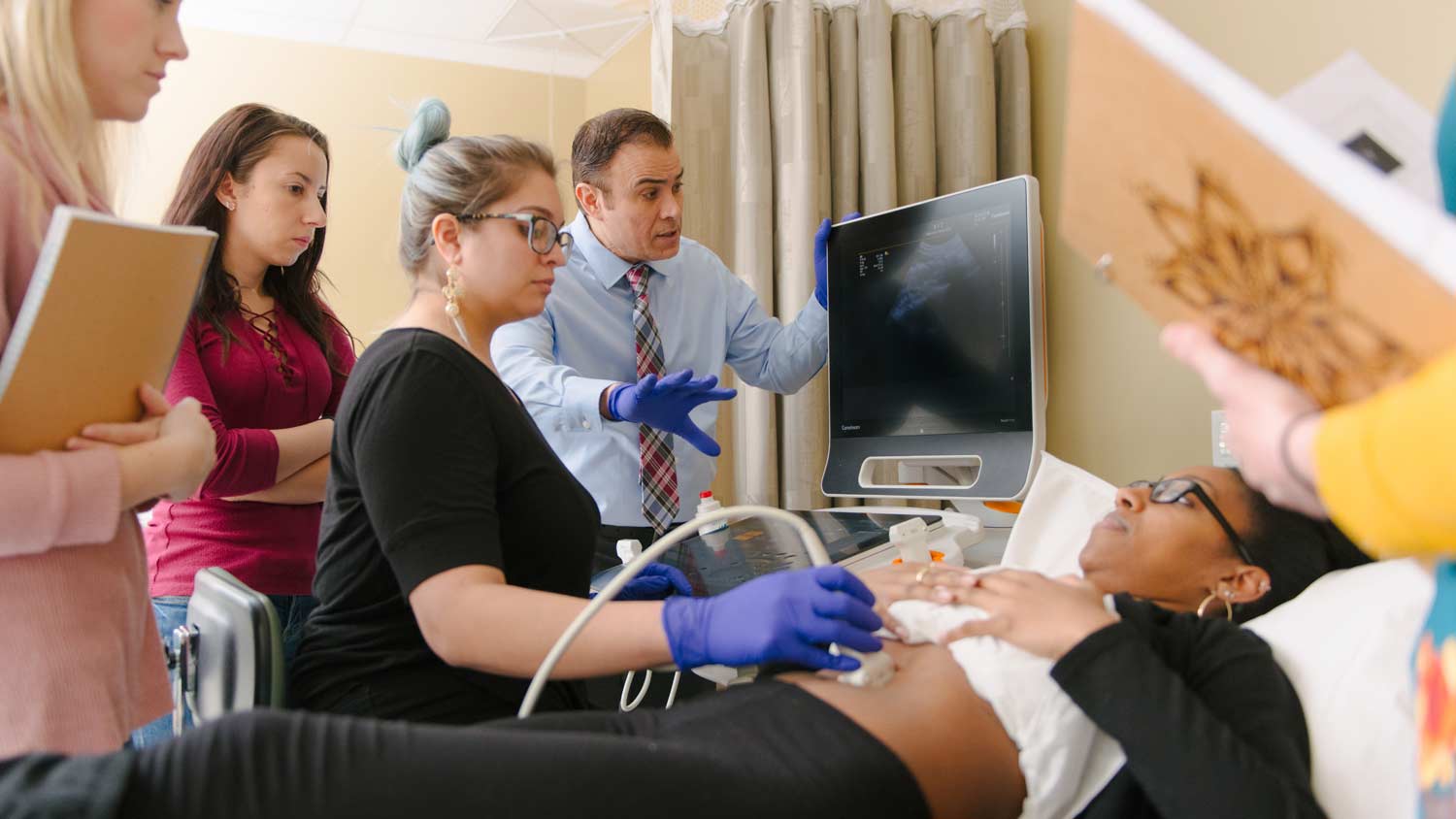Diagnostic Medical Sonography (Ultrasound) Bachelor of Science Degree

Diagnostic Medical Sonography (Ultrasound)
Bachelor of Science Degree
- RIT /
- College of Health Sciences and Technology /
- Academics /
- Diagnostic Medical Sonography (Ultrasound) BS
Overview for Diagnostic Medical Sonography (Ultrasound) BS
A rigorous, hands-on approach, coupled with a strong emphasis on experiential clinical learning–in both our state-of-the-art Ultrasound Scanning Suite and at our affiliated hospitals and clinics–provides you with a remarkable educational advantage.
Our forward-thinking curriculum integrates technology and health care to prepare graduates for immense career opportunities where you can manage and lead in environments where technology and medicine converge.
Engaging, passionate faculty are national leaders in ultrasound education and are fully committed to helping you develop into an exceptional sonographer and leader.
An exceptional option for pre-med and graduate programs in health care professions. With the addition of a few extra courses, the program’s curriculum covers the required course work that positions you as a strong candidate for medical, dental, or other graduate programs in the medical or health sciences.
Imagine the possibilities that can result from attending a nationally-ranked ultrasound program that houses a modern, state-of-the-art scanning suite where classes are taught by outstanding faculty who are leaders in their field. The outcome is a first-rate educational experience, complete with one year of on-site clinical training, that sets you a path for success in a dynamic health care field.
What is Diagnostic Medical Sonography?
Diagnostic medical sonography, also referred to as ultrasound, has revolutionized the field of medicine. It offers a unique opportunity in the diagnosis, evaluation, and treatment of medical diseases and conditions without the use of surgery, injection of dyes, or radiation. Diagnostic medical sonography is a noninvasive, nontoxic diagnostic medical imaging tool in which high-frequency sound waves are used to produce images of the human body. Ultrasound is readily used to image the heart, blood flow, and abdominal organs as well as the developing fetus and male/female reproductive organs. But ultrasound has found itself to be a critical health care tool beyond radiology, OB/GYN, vascular, and cardiology. It is now used in areas such as emergency medicine, orthopedics, sports medicine, ophthalmology, rheumatology, pain medicine, intensive care, and more. The profession has grown rapidly in the last 20 years and careers in diagnostic medical sonography are expected to continue to grow over the next several decades. Evaluation of the job market, advancements in medical technology, and a survey of current employers all indicate a strong demand for well-trained sonographers.
How to Become a Diagnostic Medical Sonographer
Our diagnostic medical sonography degree is a four-year program that includes a one year clinical internship. RIT is one of very few colleges with ultrasound programs in the U.S. that lead to a bachelor of science in diagnostic medical sonography.
RIT’s ultrasound program provides comprehensive sonography education. The program begins with a solid foundation in biology, human anatomy and physiology, and human cross-sectional anatomy. Sonography courses include extensive didactic lectures with full immersion ultrasound scanning in our state-of-the-art Ultrasound Scanning Suite, where students have hands-on instruction in sonography instrumentation and sonographic scanning skills and techniques for vascular evaluation, obstetrics, gynecology, and abdominal and small parts sonography. These courses occur before a one-year clinical internship, where students work in a range of health care settings (hospitals, outpatient centers, physician offices, etc.) where they complete their sonography education with mentors, physicians, and other medical professionals. Courses in patient care and the liberal arts round out your studies. In addition to the development of scanning and diagnostic abilities that focus on relevancy to clinical practice, the program also emphasizes skills in administration, leadership, and research. You will be prepared for careers in diagnostic medical sonography and related medical fields, as well as for medical school and graduate programs in the health sciences. This is a program that provides a high-quality, comprehensive diagnostic medical sonography education. You will graduate well-prepared, well-trained, and sought-after in the workplace.
Apply Your Knowledge
With a rigorous hands-on approach, coupled with an emphasis placed on experiential learning, you will gain a wealth of experience applying what you’ve learned in classroom lectures and lab experiences to a variety of real-life situations. A dedicated faculty is both engaged and passionate about your education and is fully committed to the development of exceptional sonographers and leaders.
Graduates are prepared to pursue a variety of careers in diagnostic medical sonography, nationally and internationally, in medical, industrial, and educational settings. Graduates can be found in a wide range of supervisory and administrative positions in hospitals, clinics, private physicians’ offices, teaching, research, sales, and industry. Graduates also can work as freelance sonographers or for mobile services.
Medical Community Support
Our diagnostic medical sonography degree benefits from a comprehensive, supportive medical community comprised of highly-trained radiologists, physicians, sonologists, sonographers, and echocardiographers that guide, educate, and train our students. Many of these professionals are involved in teaching our students both on-campus and at off-campus clinical sites. Our partner clinical sites also employ many of our graduates. Through these interactions, you are exposed to generous and dedicated health care professionals who will enhance your education through professional development, increase your awareness of community needs, and share a sense of cooperative spirit in which medicine is practiced. In addition, many of our clinical instructors, echocardiographers, and sonographers are alumni of our program and are familiar with the standards, expectations, and rigor of the ultrasound program. Learn more about the program's affiliated faculty.
Ultrasound Program Effectiveness Data
Review the Program Outcomes data.
Additional Sonography Education Opportunities
In addition to the bachelor of science in diagnostic medical sonography, RIT also offers two diagnostic medical sonography certificate programs: a certificate in diagnostic medical sonography and a certificate in echocardiography (cardiac ultrasound). Both of these options are not only designed to meet the growing needs of the national and international medical communities but also the needs of individuals who:
- Hold a degree in the life sciences and other closely related degrees who are interested in that may be approved by the program director. Additional pre-requisite course work may be required for any type and level of degree.
- Have a current, active license or registry in an area of medical or allied health sciences, some examples of medical or allied health sciences areas include respiratory therapy, nuclear medicine, physical therapy, radiography (x-rays), nursing, and more. Any of the more than 200 medical or allied health sciences fields also will be considered.
Sonography as a Pre-Med Option
Being accepted into a medical graduate program requires certain qualifications, including completing prerequisite courses, a strong academic record, acquiring pertinent experiences in the field, and developing key intrapersonal and interpersonal qualities. The Pre-Health Professions Program works with all students on an individual basis to help them become competitive candidates for admission to graduate programs in the medical and health professions.
The diagnostic medical sonography degree has assisted students in entering the worlds of medicine and dentistry. With the addition of a few courses, and without extending your time at RIT, the ultrasound program can prepare you for medical, dental, or other graduate school programs in the medical or health sciences. Graduates of the ultrasound program have gone on to become physicians, dentists, chiropractors, and more. Learn more about how a diagnostic medical sonography degree can be used as a pre-med option.
Sonography Education Resources
Program Policy and Procedures Handbook/Technical Standards
Please refer to these two documents for more information:
Prospective students are invited to view the diagnostic medical sonography program brochure.
Combined Accelerated Bachelor's/Master's Degrees
Today’s careers require advanced degrees grounded in real-world experience. RIT’s Combined Accelerated Bachelor’s/Master’s Degrees enable you to earn both a bachelor’s and a master’s degree in as little as five years of study, all while gaining the valuable hands-on experience that comes from co-ops, internships, research, study abroad, and more.
+1 MBA: Students who enroll in a qualifying undergraduate degree have the opportunity to add an MBA to their bachelor’s degree after their first year of study, depending on their program. Learn how the +1 MBA can accelerate your learning and position you for success.
-
Apply for Fall 2025
First-year students can apply for Early Decision II by Jan. 1 to get an admissions and financial aid assessment by mid-January.
Careers and Clinical Internships
Typical Job Titles
| Diagnostic Medical Sonographer | Ultrasound Technologist | Registered Diagnostic Medical Sonographer |
| Sonographer |
Graduates work primarily in the Health Care industry.
Clinical Internships
The one-year clinical internship provides hands-on experience at two or more approved medical facilities. After completing the pre-internship course work, all students begin the internship by attending an intensive two-week experience on campus. During this time they enhance and polish the skills they previously learned, prepare to perform complete sonographic examinations as performed in real clinical settings, and advance their knowledge in recognizing anatomy and disease states using a variety of equipment in the Ultrasound Scanning Suite. Students also learn about hospital, departmental, and administrative operations. After completing these requirements, candidates are assigned to a medical training site for their clinical experience. At these facilities, students work side-by-side with sonographers, physicians, and other health care professionals to learn, develop, apply, and sharpen the necessary skills to perform general ultrasound examinations. Students’ clinical progress and performance are closely monitored by the program’s clinical coordinator and program director, who have regular communication and make periodic visits to the clinical internship sites. Additionally, students return to campus each month for three days of lectures, presentations, projects, and testing. Students may complete their clinical internships at any approved regional or national medical ultrasound facility, with approval of the program director.
Featured Work and Profiles
-
Alumnae Launch Echomentor, An Educational Platform for Sonographers
Echomentor is an online platform for continuing education, mentorship, professional development, and more.
Read More about Alumnae Launch Echomentor, An Educational Platform for Sonographers -
Tiger Testing Team Offers Health Science Majors Unmatched Clinical Experience
More than 25% of the nearly 90 students that make up the Tiger Testing Team are majors in the College of Health Sciences and Technology. To help keep campus safe, the team conducted thousands of COVID...
Read More about Tiger Testing Team Offers Health Science Majors Unmatched Clinical Experience -
Alumna Pairs Ultrasound with Entrepreneurship to Launch Mobile Ultrasound Business
Hey, Baby! Mobile 4D Ultrasound is Jenny Kron's mobile ultrasound business. Kron provides elective ultrasounds in the comfort of people’s homes with a portable ultrasound machine.
Read More about Alumna Pairs Ultrasound with Entrepreneurship to Launch Mobile Ultrasound Business -
Diagnostic Medical Sonography Students Poised to Graduate
Trisha Taft and Juliana Bermudez Trisha Taft and Juliana Bermudez, Class of 2023
Read More about Diagnostic Medical Sonography Students Poised to Graduate
Curriculum for 2024-2025 for Diagnostic Medical Sonography (Ultrasound) BS
Current Students: See Curriculum Requirements
Diagnostic Medical Sonography, BS degree, typical course sequence
| Course | Sem. Cr. Hrs. | |
|---|---|---|
| First Year | ||
| BIOL-101 | General Biology I (General Education) This course serves as an introduction to cellular, molecular, and evolutionary biology. Topics will include: a study of the basic principles of modern cellular biology, including cell structure and function; the chemical basis and functions of life, including enzyme systems and gene expression; and the origin of life and evolutionary patterns of organism development on Earth. Lecture 3 (Fall, Summer). |
3 |
| BIOL-102 | General Biology II (General Education) This course serves as an introduction to animal and plant anatomy and physiology, in addition to the fundamentals of ecology. Topics will include: animal development; animal body systems; plant development; unique plant systems; Earth's terrestrial and aquatic environments; population and community ecology; animal behavior; and conservation biology. Lecture 3 (Spring, Summer). |
3 |
| BIOL-103 | General Biology I Lab (General Education) This course provides laboratory work to complement the lecture material of General Biology I. The experiments are designed to illustrate concepts of basic cellular and molecular biology, develop laboratory skills and techniques for microscopy, and improve ability to make, record and interpret observations. (Co-requisites: BIOL-101 or equivalent course.) Lab 3 (Fall, Summer). |
1 |
| BIOL-104 | General Biology II Lab (General Education) This course provides laboratory work to complement the material of General Biology II. The experiments are designed to illustrate concepts of animal and plant anatomy and physiology, develop laboratory skills and techniques for experimenting with live organisms, and improve ability to make, record, and interpret observations. (Co-requisites: BIOL-102 or equivalent course.) Lab 3 (Spring, Summer). |
1 |
| MATH-111 | Precalculus (General Education – Mathematical Perspective A) This course provides the background for an introductory level, trigonometry-based calculus course. Topics include functions and their graphs, with an emphasis on functions that commonly appear in calculus including polynomials, rational functions, trigonometric functions, exponential functions, and logarithmic functions. The course also includes the analytic geometry of conic sections. One hour each week will be devoted to a collaborative learning workshop. (Prerequisites: Students may not take and receive credit for MATH-101 and MATH-111. See the Math department with any questions.) Lecture 3, Recitation 1 (Fall, Spring). |
3 |
| STAT-145 | Introduction to Statistics I (General Education – Mathematical Perspective B) This course introduces statistical methods of extracting meaning from data, and basic inferential statistics. Topics covered include data and data integrity, exploratory data analysis, data visualization, numeric summary measures, the normal distribution, sampling distributions, confidence intervals, and hypothesis testing. The emphasis of the course is on statistical thinking rather than computation. Statistical software is used. (Prerequisites: Any 100 level MATH course, or NMTH-260 or NMTH-272 or NMTH-275 or (NMTH-250 with a C- or better) or a Math Placement Exam score of at least 35.) Lecture 3 (Fall, Spring, Summer). |
3 |
| YOPS-10 | RIT 365: RIT Connections RIT 365 students participate in experiential learning opportunities designed to launch them into their career at RIT, support them in making multiple and varied connections across the university, and immerse them in processes of competency development. Students will plan for and reflect on their first-year experiences, receive feedback, and develop a personal plan for future action in order to develop foundational self-awareness and recognize broad-based professional competencies. (This class is restricted to incoming 1st year or global campus students.) Lecture 1 (Fall, Spring). |
0 |
General Education – Elective |
3 | |
General Education – Ethical Perspective |
3 | |
General Education – Artistic Perspective |
3 | |
General Education – Social Perspective |
3 | |
General Education – Global Perspective |
3 | |
General Education – First Year Writing (WI) |
3 | |
| Second Year | ||
| MEDS-201 | Language of Medicine (General Education) Language is a systematic means or method of communicating ideas, events, or feelings. It is a combination of words or symbols used to encode and decode information. Medicine has a language to communicate information regarding the human body, its functions, diseases, tests, and procedures. This course explores the language of medicine, the rules of “language,” language mechanics that apply how to create words, define terms, and identify abbreviations. In addition to learning the fundamentals, the student will gain experience in writing, using the language of medicine, as well as interpreting that language into everyday English. Lecture 3 (Fall, Spring, Summer). |
3 |
| MEDS-250 | Human Anatomy and Physiology I (General Education) This course is an integrated approach to the structure and function of the nervous, endocrine, integumentary, muscular and skeletal systems. Laboratory exercises include histological examination, actual and simulated anatomical dissections, and physiology experiments with human subjects. (Pre-requisite: (BIOL-123 and BIOL-124 and BIOL-125 and BIOL-126) or (BIOL-123 and BIOL-124) or (BIOL-101 and BIOL-102) or (BIOL-121 and BIOL-122) or MEDG-102 or equivalent course or NUTR-BS or NUTRSC-BS students.) Lab 3, Lecture 3 (Fall). |
4 |
| MEDS-251 | Human Anatomy and Physiology II (General Education) This course is an integrated approach to the structure and function of the gastrointestinal, cardiovascular, immunological, respiratory, excretory, and reproductive systems with an emphasis on the maintenance of homeostasis. Laboratory exercises include histological examinations, anatomical dissections and physiological experiments using human subjects. (Pre-requisite: (BIOL-123 and BIOL-124 and BIOL-125 and BIOL-126) or (BIOL-123 and BIOL-124) or (BIOL-101 and BIOL-102) or (BIOL-121 and BIOL-122) or MEDG-102 or equivalent course or NUTR-BS or NUTRSC-BS students.) Lab 3, Lecture 3 (Spring). |
4 |
| PHYS-111 | College Physics I (General Education – Natural Science Inquiry Perspective) This is an introductory course in algebra-based physics focusing on mechanics and waves. Topics include kinematics, planar motion, Newton’s laws, gravitation; rotational kinematics and dynamics; work and energy; momentum and impulse; conservation laws; simple harmonic motion; waves; data presentation/analysis and error propagation. The course is taught using both traditional lectures and a workshop format that integrates material traditionally found in separate lecture, recitation, and laboratory settings. Attendance at the scheduled evening sessions of this class is required for exams. There will be 2 or 3 of these evening exams during the semester. Competency in algebra, geometry and trigonometry is required. Lab 4, Lecture 2 (Fall, Spring, Summer). |
4 |
| PHYS-112 | College Physics II (General Education – Scientific Principles Perspective: This course is an introduction to algebra-based physics focusing on thermodynamics, electricity and magnetism, and elementary topics in modern physics. Topics include heat and temperature, laws of thermodynamics, electric and magnetic forces and fields, DC and AC electrical circuits, electromagnetic induction, the concept of the photon, and the Bohr model of the atom. The course is taught using both traditional lectures and a workshop format that integrates material traditionally found in separate lecture, recitation, and laboratory settings. Attendance at the scheduled evening sessions of this class is required for exams. There will be 2 or 3 of these evening exams during the semester. (Prerequisites: PHYS-111 or PHYS-211 or equivalent course.) Lab 4, Lecture 2 (Fall, Spring). |
4 |
General Education – Immersion 1, 2 |
6 | |
Open Electives |
6 | |
| Third Year | ||
| DCHP-333 | Patient Care Students will be introduced to key elements of integrated, high-quality patient care. Through lectures, videos, demonstrations, and discussions essential aspects of team-based patient care will be explored. Vital skills and behaviors such as professionalism, communication, documentation, workplace safety, patient assessment, patient positioning and transfers will be presented. Infection control, global health issues, and medications will also be examined. Students will be encouraged to share their personal experiences and thoughts about class topics. (Prerequisites: (BIOL-123 and BIOL-125 and BIOL-124 and BIOL-126) or (BIOL-101 and BIOL-102 and BIOL-103 and BIOL-104) or (BIOL-121 and BIOL-122) or equivalent courses.) Lecture 2 (Spring). |
2 |
| DCHP-415 | Pathophysiology of Organ Systems I This course is designed to provide the students with the necessary foundation of the physiologic and pathologic processes that underlie the spectrum of human disease entities and is taught in the context of clinical scenarios that demonstrate the basic science principles in a real-world context of health care. Emphasis is placed on the fundamental principles of cell injury and repair, infection, neoplasia, and inflammation as well as hemodynamic disorders, thromboembolic disease and shock. Additional emphasis is placed on organ systems and their disorders such as the circulatory, liver, gallbladder and biliary systems. Material is presented in the context of case studies, utilizing clinical findings and addressing underlying basic physiologic, biochemical and immunologic processes as they relate to patient care and individual patient problem cases. (Prerequisites: Restricted to students in the College of Health Sciences and Technology with at least 3rd year standing who have completed MEDS-250 and MEDS-251 or equivalent courses.) Lecture 3 (Fall). |
3 |
| DMSO-301 | Sonographic Scanning Skills and Techniques I The course provides students with hands-on experience by performing basic and general abdominal, small parts, obstetrical and gynecological ultrasound examinations. Sonographic examination protocols and techniques, review and recognition of normal anatomic structures, high quality image production, and image interpretation are stressed. (Prerequisites: DMSO-BS or DMSO-CT and YR 3) Lec/Lab 6 (Fall). |
3 |
| DMSO-302 | Sonographic Scanning Skills and Techniques II The course is a continuation of Sonographic Scanning Skills and Techniques I (DMSO- 301). The course provides students with further hands-on opportunities to perform advanced abdominal and OB/GYN, peripheral vascular (upper and lower) and carotid Doppler examinations including color flow. Ultrasound examination protocols and techniques, review and recognition of normal anatomic structures, high quality image production, Doppler and color flow optimization and image interpretation are stressed. (Prerequisites: DMSO-301 or equivalent course.) Lec/Lab 6 (Spring). |
3 |
| DMSO-309 | Sonography Physics and Instrumentation I This course addresses how the principles of ultrasound physics are directly applied to the use of ultrasound instrumentation in medical imaging. Transducers, signal production, memory systems, data display, manipulation of controls, and artifacts, are discussed. Throughout the course, the student will integrate previous knowledge of anatomy with ultrasound physics and instrumentation. (Prerequisites: PHYS-112 or equivalent course and student standing in DMSO-CT, DMSO-BS or ECHO-CT.) Lec/Lab 6 (Fall). |
3 |
| DMSO-310 | Sonography Physics and Instrumentation II This course is a continuation of Sonography Physics and Instrumentation I (DMSO-309). It provides a foundation of the basic physical principles of ultrasound and the fundamentals of fluid dynamics, Doppler physics including color, power, and spectral Doppler, quality control, Doppler artifacts, and biological effects. Students will learn to integrate previous knowledge of anatomy, ultrasound physics and instrumentation with Doppler skills and techniques. Development of scanning techniques, use of instrument controls, and production of high quality diagnostic images utilizing laboratory equipment are stressed. (Prerequisites: DMSO-309 or equivalent course.) Lec/Lab 6 (Spring). |
3 |
| DMSO-312 | Human Cross-Sectional Anatomy This course covers basic sectional anatomy of the abdomen, pelvis, fetus and small parts, building on the basic knowledge of anatomy. This course prepares the student to recognize sectional anatomy of major human structures, especially as they relate to medical imaging techniques. Lectures are augmented with exercises using prepared human sections, organ modeling, and diagnostic imaging units. (Prerequisites: DMSO-BS or DMSO-CT and YR 3) Lecture 3 (Fall). |
3 |
General Education – Immersion 3 |
3 | |
Open Electives |
6 | |
| Fourth Year | ||
| DMSO-414 | Sonographic Vascular Evaluation This course provides knowledge of general vascular evaluation with an emphasis on the Sonographic approach. Two-dimensional real-time imaging and Doppler techniques are presented as well as a discussion of other imaging modalities and their use in vascular evaluation. Performance of examinations on laboratory equipment is stressed. (Prerequisites: DMSO-BS or DMSO-CT and YR 4) Lec/Lab 3 (Spring). |
3 |
| DMSO-452 | Obstetrical Sonography I This course provides the ultrasound candidate with the knowledge necessary to perform obstetrical examinations. High-quality image production, recognition of normal structures, and basic pathologic states are stressed. Examination protocols, review of specific anatomy and pathology, film reading, and use of other imaging techniques are also addressed. (Prerequisites: DMSO-BS or DMSO-CT and YR 4) Lec/Lab 3 (Fall). |
3 |
| DMSO-453 | Gynecological Sonography This course provides the information necessary to perform basic and advanced gynecologic Sonographic examinations. Examination strategies for various procedures are explored, as well as the integration of ultrasound into established clinical practices. (Prerequisites: DMSO-BS or DMSO-CT and YR 4) Lec/Lab 4 (Fall). |
3 |
| DMSO-454 | Obstetrical Sonography II This course provides information necessary to perform more sophisticated obstetrical procedures utilizing ultrasound equipment. Examination strategies for various procedures are explored as well as the integration of ultrasound into established clinical practices. (Prerequisites: DMSO-BS or DMSO-CT and YR 4) Lec/Lab 3 (Spring). |
3 |
| DMSO-456 | Abdominal and Small Parts Sonography I Laboratory simulation and classroom instruction are used to develop practical skills and clinical knowledge necessary to perform basic abdominal and small parts examinations utilizing ultrasound equipment. High-quality image production, recognition of normal abdominal structures and basic pathologic states are stressed. Examination protocols, review of anatomy, film reading, and use of other scanning techniques are addressed. (Prerequisites: DMSO-BS or DMSO-CT and YR 4) Lec/Lab 4 (Fall). |
3 |
| DMSO-457 | Abdominal and Small Parts Sonography II This course is a continuation of Abdominal and Small Parts Sonography I (DMSO-456). Laboratory simulation and classroom instruction are used to develop the practical skills and clinical knowledge necessary to perform basic and advanced abdominal and small parts examinations utilizing ultrasound. High-quality image production, recognition of normal abdominal structures and basic and advanced pathologic states are stressed. Examination protocols, review of anatomy, film reading and use of other scanning techniques are addressed. (Prerequisites: DMSO-BS or DMSO-CT and YR 4) Lec/Lab 4 (Spring). |
3 |
| DMSO-460 | Administration and Research in Sonography (WI-PR) Speaking, writing, and researching skills are explored. Methods of basic research, developing writing strategies, and oral presentations are stressed. Students develop or critique a research project and prepare a written document following common publishing guidelines in addition to making oral presentations. Additionally, candidates prepare a complete plan for an ultrasound department as if they had been hired to establish a new department in a hospital setting. The candidates work together to develop the physical facilities, administrative, and financial aspects of a department. (Prerequisites: DMSO-BS or DMSO-CT and YR 4) Lecture 3 (Spring). |
3 |
| DMSO-570 | Clinical Sonography I This course prepares the student for application of classroom knowledge to the practice of ultrasound by means of a clinical internship. Performing basic general ultrasound examinations in the areas of abdomen, small parts, obstetrics, gynecology and basic peripheral vascular in both the laboratory and clinical settings is stressed. Nursing procedures, ethical issues, and medico-legal considerations are also discussed as they relate to the practice of ultrasound examinations. This is an internship course. (Prerequisites: DMSO-BS or DMSO-CT and YR 4) Lec/Lab 7 (Fall). |
7 |
| DMSO-571 | Clinical Sonography II This course provides the final development of ultrasound examination skills by means of clinical internship. The candidate is expected to perform basic and advanced general ultrasound examinations in the areas of abdomen, small parts, obstetrics, gynecology and peripheral ultrasound examinations with no assistance by the end of this course. This is an internship course. (Prerequisites: DMSO-570 or equivalent course.) Lec/Lab 5 (Spring). |
5 |
| Total Semester Credit Hours | 125 |
|
Please see General Education Curriculum (GE) for more information.
(WI) Refers to a writing intensive course within the major.
Please see Wellness Education Requirement for more information. Students completing bachelor's degrees are required to complete two different Wellness courses.
Admissions and Financial Aid
First-Year Admission
First-year applicants are expected to demonstrate a strong academic background that includes:
- 4 years of English
- 3 years of social studies and/or history
- 3 years of math is required and must include algebra, geometry, and algebra 2/trigonometry. Pre-calculus is preferred.
- 2-3 years of science. Biology is required. Chemistry and physics are preferred.
Transfer Admission
Transfer applicants should meet these minimum degree-specific requirements:
- A minimum of college algebra is required. Pre-calculus or calculus is preferred.
- Biology is required. Physics is preferred.
Financial Aid and Scholarships
100% of all incoming first-year and transfer students receive aid.
RIT’s personalized and comprehensive financial aid program includes scholarships, grants, loans, and campus employment programs. When all these are put to work, your actual cost may be much lower than the published estimated cost of attendance.
Learn more about financial aid and scholarships
Accreditation
The Abdomen-Extended, Obstetrics and Gynecology, and Adult Cardiac DMS Program at Rochester Institute of Technology is accredited by the Commission on Accreditation of Allied Health Education Programs (www.caahep.org) upon the recommendation of the Joint Review on Education in Diagnostic Medical Sonography (JRC-DMS).
CAAHEP
9355 - 113th St. N, #7709
Seminole, FL 33775
727-210-2350
www.caahep.org
JRC-DMS
6021 University Blvd., Suite 500
Ellicott City, MD 21043
443-973-3251
www.jrcdms.org
It is noteworthy to mention that the diagnostic medical sonography degree is institutionally accredited and programmatically accredited. This type of dual accreditation meets both professional and employer requirements and also allows our graduates to immediately sit for the national board examinations administered by the American Registry of Diagnostic Medical Sonography (ARDMS).
Facilities
-
![A group of people performing a sonogram on a patient]() Ultrasound Scanning Suite
Ultrasound Scanning SuiteTo remain a leader in educating technically sound sonographers, the diagnostic medical sonography program emphasizes not only on the didactic aspect of learning, but also the practical, hands-on, clinical aspect.
Related News
-
November 12, 2024
![two women sit on a gray couch in a white livingroom with art on the walls.]()
EchoMentor creates a new wave of sonographers
Hayley Bartkus and Christina Werth created EchoMentor as an educational platform for healthcare professionals working in sonography or ultrasound, a medical imaging method that uses sound waves to peer inside the body.
-
May 3, 2024
![a family stands in a livingroom all wearing R I T shirts.]()
Two graduates bring new meaning to legacy family
Two RIT students graduating next week continue their family legacies while pioneering unique paths in their fields.
-
December 1, 2023
![graphic with the text, 20 23 to 20 24 distinguished alumni awards.]()
Distinguished Alumni Award winners named for 2023-2024
Twelve RIT alumni have been honored with Distinguished Alumni Awards for the 2023-2024 year. The Distinguished Alumni Awards are presented annually by each of RIT’s nine colleges, the School of Individualized Study, and the RIT Graduate School to alumni who have performed at the highest levels of their profession or who have contributed to the advancement and leadership of civic, philanthropic, or service organizations.
Contact
- Hamad Ghazle
- Department Head of Clinical Health Professions
- Department of Clinical Health Professions
- College of Health Sciences and Technology
- 585‑475‑2241
- hhgscl@rit.edu
















